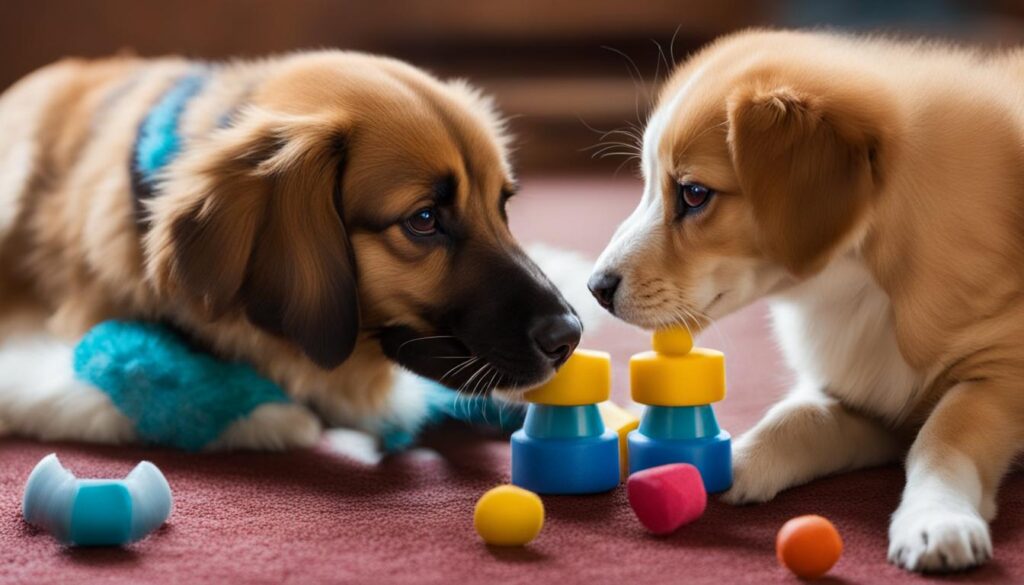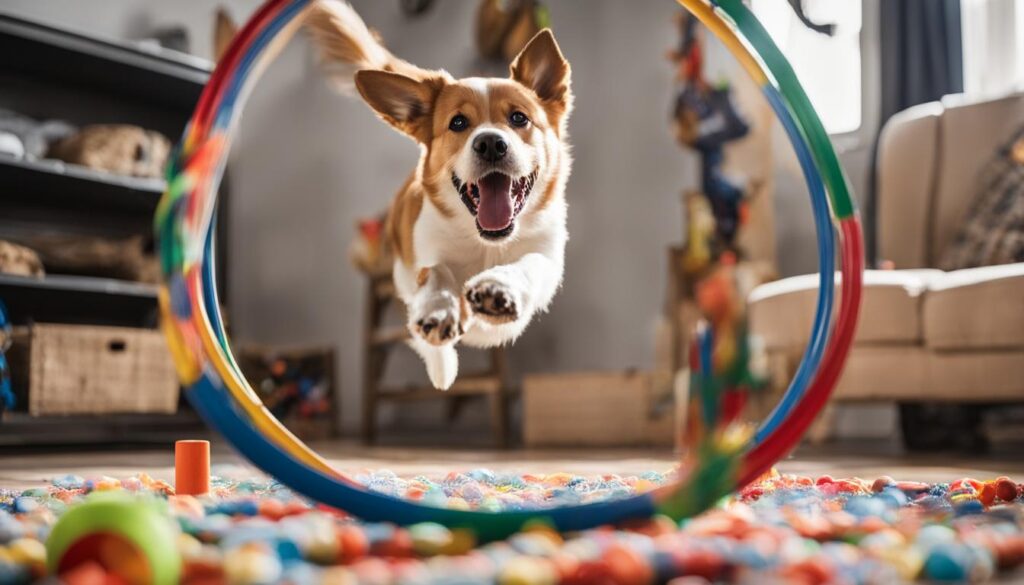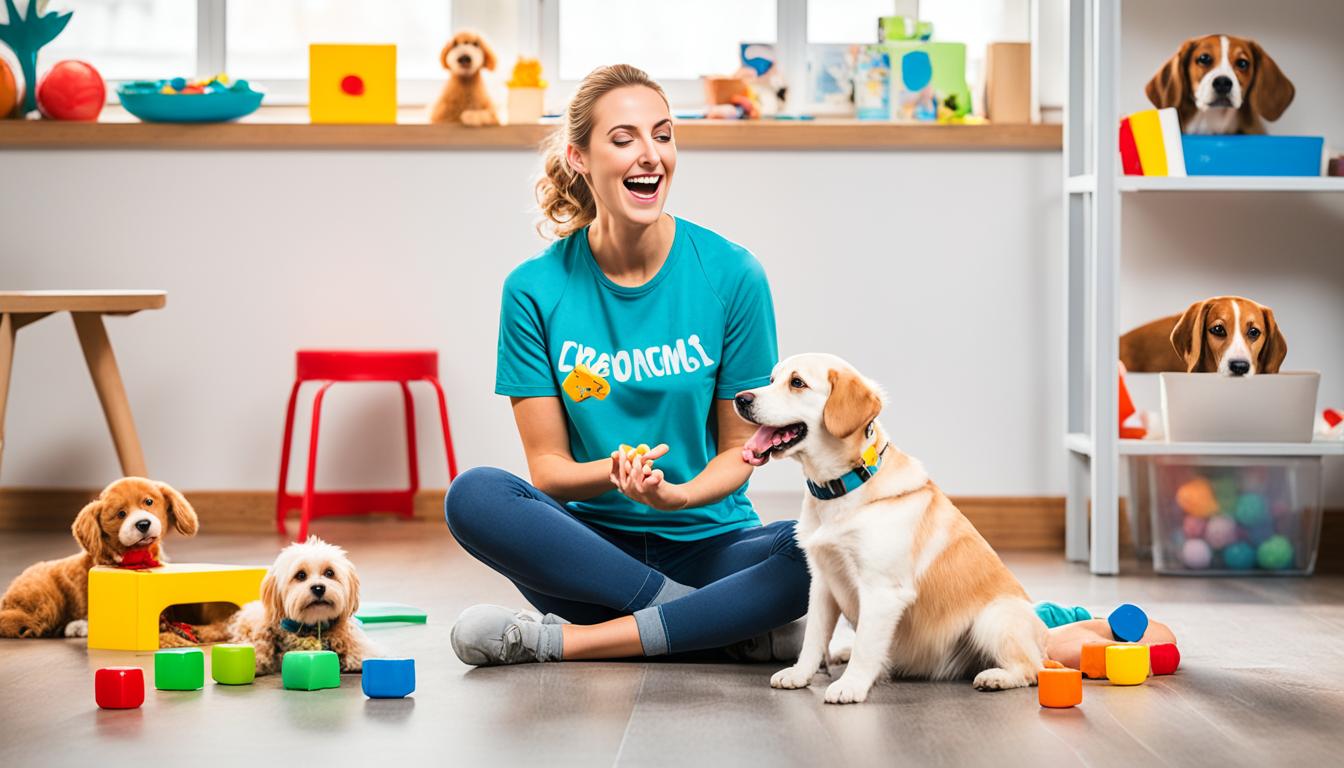The Art of Training: Creating Harmony and Understanding with Your Pet!
Welcome to our comprehensive guide on pet training! At our core, we believe that successful training is the key to creating a harmonious relationship with your beloved pets. Whether you have a dog, cat, or puppy, training is an essential tool for promoting positive behaviors and a deep understanding between you and your furry companion.
In this section, we will delve into the world of pet training, exploring techniques and strategies that have proved effective in training pets for success. From obedience training to leash training, we will cover a wide range of training methods that will address behavior issues and foster a well-behaved pet.
Using positive reinforcement as a guiding principle in our training approach, we aim to create a nurturing environment that strengthens the bond between pet owners and their pets. By understanding the unique needs and behaviors of your pet, you can tailor your training techniques to ensure the best possible outcome.
Key Takeaways:
- Training your pet for success is crucial for creating harmony and understanding in your relationship.
- Utilize positive reinforcement techniques to promote desired behaviors in your pet.
- Understanding your pet’s behavior is essential for effective training.
- Consistency and patience are key elements for successful pet training.
- Remember to establish yourself as the pack leader to maintain a well-balanced environment.
The Benefits of a Multi-Dog Household and their Training Needs
In this section, we will explore the advantages of owning multiple dogs and the training needs that come with a multi-dog household. Having more than one dog in your home can bring numerous benefits, fostering companionship, socialization, and a balanced environment for exercise. Additionally, it provides pet owners with the opportunity to strengthen their bonds with each individual dog through various training techniques.
Promoting Companionship and Socialization
Owning multiple dogs promotes companionship among the furry members of your family. Dogs are social animals, and having companions to interact with can greatly enhance their overall well-being. When dogs live together, they form their own unique pack, sharing experiences, and creating a sense of belonging. This companionship can help alleviate separation anxiety and provide emotional support to each other.
A multi-dog household also encourages socialization. Dogs that live together learn how to interact with other dogs effectively, improving their canine communication skills. This is particularly beneficial for young dogs as they observe and mimic appropriate behaviors from their older counterparts. Regular socialization within the household can lead to confident and well-adjusted dogs.
Fostering a Balanced Environment for Exercise
Owning multiple dogs naturally fosters a balanced environment for exercise. Dogs are active creatures that require regular physical activity to maintain their health and happiness. In a multi-dog household, dogs can engage in play and exercise together, which stimulates both their bodies and minds.
A multi-dog household provides opportunities for group activities such as playing fetch, going for walks, or participating in agility training. These shared experiences not only provide exercise but also strengthen the bonds between dogs. Additionally, the presence of other dogs can help motivate and energize each dog, making their exercise routines more enjoyable.
Building Bonds through Training Techniques
Training is an essential aspect of owning multiple dogs and further strengthens the bonds between dogs and their owners. Through training, dogs learn important obedience commands, such as sit, stay, and come, ensuring their safety and enhancing their overall behavior. Training also provides mental stimulation and helps prevent behavioral issues that may arise in multi-dog households.
Training techniques such as positive reinforcement, using rewards and praise, are particularly effective in encouraging desired behaviors in dogs. By training dogs together, owners can create a cooperative learning environment, where dogs observe and learn from each other. This not only promotes unity within the pack but also facilitates the learning process for individual dogs.
| Benefits of a Multi-Dog Household | Training Needs |
|---|---|
| Promotes companionship and socialization | Teach dogs to interact appropriately |
| Fosters a balanced environment for exercise | Engage in group activities and games |
| Strengthens bonds between dogs | Train dogs together using positive reinforcement |
Understanding Your Pets’ Behavior for Effective Training
When it comes to pet training, understanding your pet’s behavior is an essential factor for success. By comprehending the underlying motivations and triggers behind certain behaviors, pet owners can tailor their training methods accordingly, resulting in more effective and positive outcomes.
Behavior analysis plays a crucial role in pet training. It involves observing and assessing your pet’s actions to identify patterns, motivations, and possible causes of unwanted behaviors. Through behavior analysis, you can gain valuable insights into why your pet behaves a certain way and what factors may be influencing their actions.
“Understanding your pet’s behavior allows you to address the root causes of unwanted behaviors instead of merely treating the symptoms.”
By analyzing your pet’s behavior, you can modify and reshape their actions by reinforcing desired behaviors while discouraging unwanted ones. For example, if your dog barks excessively when visitors arrive, behavior analysis might reveal that they are seeking attention or feeling anxious. Understanding this can help you address the issue through training techniques that promote calm behavior and teach your dog alternative ways to greet guests.
When training based on pet behavior, it’s important to focus on positive reinforcement rather than punishment. Reward-based training techniques can have a significant impact on pet training success. Positive reinforcement involves rewarding your pet with treats, praise, or playtime for demonstrating desired behaviors. This positive association with good behavior helps motivate your pet to repeat those actions in the future.
Incorporating behavior analysis into your pet training routine allows you to fine-tune your methods and make adjustments as needed. It enables you to create a training plan that is tailored to your pet’s individual needs, preferences, and personality. With a personalized approach, you can maximize the effectiveness of your training sessions and foster a stronger bond with your pet.
Training Your Pet for Success: Insights from Expert Trainers
When it comes to pet training, who better to turn to for guidance than expert trainers? In this section, we will share insights and advice from seasoned trainers that will help you train your pet for success. By following their tips and techniques, you can establish a strong foundation for effective and successful pet training.
Essential Training Commands
To ensure your pet’s obedience and safety, it’s important to teach them essential training commands. These commands serve as the building blocks for their training journey and establish clear communication between you and your pet. Expert trainers recommend focusing on the following essential commands:
- Sit
- Stay
- Come
- Leave it
- Down
By teaching these commands, you can establish control and maintain discipline during various situations. These commands also play a crucial role in ensuring your pet’s safety and well-being.
Incorporating Positive Reinforcement into Your Training Regime
Positive reinforcement is a powerful tool in pet training. This technique involves rewarding your pet for exhibiting desired behaviors, thereby increasing the likelihood of them repeating those behaviors. Expert trainers emphasize the effectiveness of positive reinforcement in pet training. By using treats, praise, or play as rewards, you can motivate and encourage your pet to learn and obey commands.
Here is an example of how positive reinforcement can be used to teach the “sit” command:
Start by holding a treat close to your pet’s nose, then slowly raise it above their head. As they follow the treat with their eyes and naturally lower their rear end, say “sit” and reward them with the treat. Repeat this process several times, gradually reducing the use of treats and relying more on praise and affection as rewards.
By incorporating positive reinforcement into your training regime, you create a positive and enjoyable learning experience for your pet.

| Insights from Expert Trainers | Essential Training Commands | Incorporating Positive Reinforcement |
|---|---|---|
| Expert trainers provide valuable insights and guidance based on their years of experience in pet training. | Essential training commands like sit, stay, come, leave it, and down form the foundation of your pet’s obedience and discipline. | Positive reinforcement, using treats, praise, or play as rewards, is an effective technique that motivates your pet to learn and obey commands. |
Strategies for Establishing Leadership in Multi-Pet Homes
Establishing leadership in a multi-pet household requires strategic approaches that promote harmony and respect among all pets. By implementing consistent and effective strategies, you can create a balanced environment where each pet understands their place and follows your guidance. In this section, we will explore two key strategies for establishing leadership in multi-pet homes: consistency and clear rules and boundaries.
Consistency as the Pillar of Leadership
Consistency is crucial when it comes to establishing yourself as the pack leader in a multi-pet household. By consistently enforcing rules and expectations, you can establish a sense of order and authority that all pets understand. This means using the same commands, gestures, and signals for each pet and following through with rewards and consequences consistently. Consistency helps pets understand what is expected of them, and it reinforces the idea that you are in charge.
Consistency also extends to daily routines and schedules. Establish a predictable routine that includes consistent feeding times, exercise sessions, and playtime for all pets. This routine helps pets feel secure and reduces anxiety or tension that can arise in a multi-pet household. By consistently providing structure and following a routine, you establish yourself as a reliable leader that pets can trust and rely on.
Achieving Obedience through Clear Rules and Boundaries
Clear rules and boundaries are essential for establishing leadership in a multi-pet household. Each pet should understand their individual boundaries and limitations, as well as the rules that apply to interactions with other pets and humans. Clearly communicate these rules through consistent training and reinforcement.
Set clear boundaries for areas of the house, furniture permissions, and sleeping arrangements to avoid conflicts and establish order. Use positive reinforcement techniques to reward desired behaviors and discourage unwanted behaviors. Consistently apply these rules and boundaries to ensure that all pets understand and respect them.
To illustrate the importance of consistency and clear rules and boundaries, let’s take a look at the following table that outlines key strategies for establishing leadership in multi-pet households:
| Strategies | Description |
|---|---|
| Consistency | Enforce rules and expectations consistently. Follow a predictable routine and schedule for all pets. |
| Clear Rules and Boundaries | Establish clear boundaries and rules for interactions, furniture permissions, and sleeping arrangements. Use positive reinforcement techniques. |
By implementing these strategies for establishing leadership in a multi-pet household, you can create a harmonious environment where all pets feel secure, respected, and obedient. Consistency and clear rules and boundaries lay the foundation for successful multi-pet training and help foster a positive relationship between you and your furry companions.
Resource Competition: Mastering Management Techniques
In a multi-pet household, resource competition can sometimes arise, leading to conflicts and tension between pets. To ensure a harmonious environment, it is essential for pet owners to master management techniques that address resource competition effectively. By implementing proper allocation strategies and addressing food, space, and toy competition, pet owners can minimize conflicts and create a balanced environment for their pets.
Addressing Food, Space, and Toy Competition
When it comes to resource competition, food, space, and toys are common triggers. Addressing these areas of competition is crucial to maintaining peace among pets. Here are some techniques to address each type of competition:
- Food Competition: Establish separate feeding areas for each pet, ensuring that each pet has their own space to eat without being disturbed. Avoid free-feeding and implement scheduled mealtimes to regulate food access and reduce competition.
- Space Competition: Provide multiple resting areas or beds throughout the house to prevent pets from feeling the need to claim a specific spot. Create vertical spaces such as cat trees or shelves to increase available territory.
- Toy Competition: Offer a variety of toys and rotate them regularly to prevent toy hoarding or possessive behavior. Supervise playtime to ensure fair and equitable access to toys.
Avoiding Resource Guarding through Proper Allocation
Resource guarding can be a challenging behavior that arises from competition over resources. To avoid resource guarding, proper allocation is key. Here are some techniques to prevent resource guarding:
- Identify Triggers: Understand what resources trigger guarding behavior in your pets. It could be food, toys, or even specific resting spots. Identifying these triggers will help in implementing appropriate management techniques.
- Positive Reinforcement: Use positive reinforcement to encourage cooperative behavior during resource allocation. Reward pets for sharing, taking turns, and displaying non-guarding behaviors.
- Gradual Desensitization: Gradually expose pets to the presence of resources and reward them for calm and non-aggressive behavior. This helps in creating positive associations and reducing guarding behavior.
By proactively addressing resource competition and implementing proper allocation strategies, pet owners can foster a harmonious environment where pets can coexist without conflicts. With patience, consistency, and attention to each pet’s individual needs, resource competition can be effectively managed, allowing for a peaceful and balanced multi-pet household.

Promoting Polite Behavior: Training Beyond Commands
In our journey to create harmony and understanding with our pets, it is crucial to go beyond basic commands and focus on promoting polite behavior. Teaching our pets manners and setting boundaries plays a pivotal role in preventing aggressive or pushy behavior. By training our pets to greet others politely and respond to cues, we can foster well-behaved and respectful companions.
Polite behavior goes beyond following commands. It encompasses how our pets interact with humans and fellow animals, their behavior in public places, and their overall demeanor. By promoting polite behavior, we create a positive environment both at home and in the community.
“Politeness is the art of choosing proper behavior, even when others may not be watching.”
– Anonymous
Teaching Pet Manners
Teaching pet manners involves instilling good behavior and social skills in our pets. By setting expectations and consistently reinforcing them, we can shape our pets’ behavior in a positive way. Here are some key aspects to consider when teaching pet manners:
- Pet Greetings: Teaching our pets to greet others politely is essential. This involves preventing jumping, excessive barking, or rushing towards guests. Instead, encourage your pet to sit or stay calmly when meeting new people.
- Leash Etiquette: Leash manners are crucial for a peaceful walk with your pet. Teach your pet to walk calmly beside you, without pulling or lunging towards distractions.
- Sharing Spaces: Set boundaries to ensure your pet understands what areas of the house are off-limits. Teach them to respect shared spaces and furniture.
- Waiting Calmly: Train your pet to wait patiently when necessary, such as during mealtime or when you open doors. This prevents them from rushing or becoming pushy in their behavior.
Celebrating and rewarding good manners is essential in the training process. Positive reinforcement, such as praise, treats, or playtime, helps solidify the polite behavior we want to encourage in our pets.
Setting Boundaries
Setting boundaries is crucial in promoting polite behavior in our pets. By defining what is acceptable and what is not, we create a clear understanding of the rules and expectations. Here are some tips for setting boundaries:
- Consistency: Consistency is key when setting boundaries. Ensure that everyone in the household is clear on the rules and enforces them consistently. This consistency will help your pet understand what behavior is expected of them.
- Redirecting Undesirable Behavior: If your pet displays unwanted behavior, such as chewing on furniture or excessive barking, provide appropriate alternatives and redirect their attention to more desirable activities. This teaches them what is acceptable and redirects their energy into positive outlets.
- Use Clear Communication: Non-verbal cues, such as hand signals or gestures, can be effective in communicating boundaries to your pet. Pairing these cues with verbal commands helps reinforce your expectations and helps your pet understand what you want them to do.
Remember that training beyond commands requires patience, consistency, and positive reinforcement. You are laying the foundation for a well-mannered and respectful pet who can thrive in various environments.
| Benefits of Promoting Polite Behavior | How to Achieve Polite Behavior |
|---|---|
| 1. Creates a harmonious environment | 1. Use positive reinforcement to reward polite behavior |
| 2. Enhances socialization skills | 2. Set clear boundaries and expectations |
| 3. Fosters positive interactions with humans and other animals | 3. Practice consistent training and reinforcement |
| 4. Builds a respectful relationship between pet and owner | 4. Redirect and correct undesirable behavior |
Creating a Structured Training Schedule for Multiple Pets
When it comes to training multiple pets, a structured schedule is a crucial component of successful pet training. By maintaining a consistent routine and integrating varied activities within training sessions, you can optimize the learning experience for your furry companions.

Integrating Varied Activities within Training Sessions
One of the keys to keeping your pets engaged and motivated during training is to incorporate a variety of activities. Just like humans, pets can quickly become bored with repetitive tasks. By introducing new challenges, tasks, or games within your training sessions, you can spark their interest and keep them enthusiastic about the learning process.
For example, if you’re teaching your dogs basic obedience commands, you can alternate between practicing indoors and outdoors to provide them with different environments and distractions. You can also introduce interactive toys or puzzles as part of the training session, which not only stimulates them mentally but also reinforces the desired behaviors.
Additionally, consider incorporating activities specific to your pets’ interests and abilities. For instance, if you have a dog that enjoys agility training, incorporate some agility exercises into your training routine. By tailoring the activities to suit their preferences, you create a more engaging training experience and foster a stronger bond with your pets.
Maintaining Consistent Routines for Optimal Learning
Consistency is key when it comes to training multiple pets. By establishing and maintaining consistent routines, you provide structure and predictability, which allows your pets to understand what is expected of them during training.
Ensure that training sessions occur at regular intervals and stick to a predetermined schedule. Consistency in timing and duration helps your pets anticipate and prepare for each session, promoting an optimal learning environment. This routine also establishes a sense of order and reduces anxiety, enabling your pets to focus better and absorb the training concepts more effectively.
In addition to training sessions, consistency should also extend to other aspects of your pets’ lives. This includes feeding times, walks, playtime, and bedtime schedules. Consistency in these areas reinforces the overall structure and facilitates better learning outcomes.
The Impact of Enrichment on Pet Behavior and Training
In order to effectively train and modify pet behavior, it is essential to understand the impact of enrichment on their overall well-being. Enrichment refers to providing pets with mental and physical stimulation that satisfies their innate needs. By incorporating enrichment activities into a pet’s daily routine, owners can prevent behavior issues and foster a healthy and balanced lifestyle.
Enrichment as a Preventive Measure for Behavior Issues
Enrichment plays a crucial role in preventing behavior issues in pets. When pets are deprived of mental and physical stimulation, they may develop unwanted behaviors such as excessive barking, chewing, digging, or aggression. Engaging pets in enriching activities helps channel their energy and prevents the manifestation of these behavior problems. By satisfying their natural instincts and providing them with appropriate outlets, pet owners can create a harmonious living environment for both themselves and their furry friends.
Activities to Satisfy Your Pet’s Innate Needs
There are numerous activities that can fulfill a pet’s innate needs and keep them mentally and physically stimulated. These activities include:
- Interactive puzzle toys that challenge pets mentally and reward them for problem-solving.
- Outdoor playtime and exercise, such as walks, runs, or visits to the dog park.
- Training sessions that stimulate their minds and reinforce positive behaviors.
- Providing appropriate chewing toys to satisfy their natural instinct to chew.
- Creating a safe and stimulating indoor environment with scratching posts, climbing trees, and hiding spots for cats.
- Introducing new smells, textures, and sounds to keep pets engaged and curious.

By incorporating these activities into their pets’ routine, owners can satisfy their innate needs and prevent behavior issues. Additionally, enrichment activities strengthen the bond between pets and their owners, as they provide opportunities for quality time and shared experiences.
In this section, we have explored the impact of enrichment on pet behavior and training. By understanding the importance of enrichment as a preventive measure for behavior issues and providing activities to satisfy pets’ innate needs, pet owners can create a harmonious living environment and improve their pet’s overall well-being.
Teaching Manners and Politeness: The Subtleties of Dog Training
In dog training, teaching manners and politeness is an essential aspect that goes beyond basic obedience commands. It involves instilling good behavior and teaching dogs how to interact politely with humans and other animals. By focusing on patient teaching and using reward-based methods, pet owners can effectively encourage and reinforce desirable behaviors in their dogs.
The Significance of Patient Teaching
Patient teaching plays a crucial role in dog training, especially when it comes to teaching manners and politeness. Dogs may not immediately understand what is expected of them, and it is important to give them time to learn and adapt. Rushing the process can lead to confusion and frustration for both the dog and the owner. By patiently guiding and reinforcing positive behaviors, owners can effectively teach their dogs manners and politeness.
Reward-Based Methods for Encouraging Good Behavior
Reward-based training methods are highly effective in teaching manners and encouraging good behavior in dogs. Instead of using punishment or harsh techniques, reward-based training focuses on positive reinforcement. This involves rewarding desired behaviors with treats, praise, or playtime to motivate dogs to repeat those behaviors. By consistently rewarding good behavior, dogs learn which behaviors are desirable and are more likely to exhibit them.
The image above illustrates the importance of teaching manners to ensure well-behaved and polite dogs. Through patient teaching and reward-based methods, pet owners can shape their dogs’ behavior and enhance their social interactions.
Advanced Training Techniques for Problem-Solving
In this section, we will explore advanced training techniques that can effectively address and resolve problematic behaviors in pets. Problem-solving is an essential aspect of pet training, as it helps pet owners tackle challenging behavior and achieve positive results. By incorporating these professional training techniques, pet owners can modify pet behavior and create a harmonious environment for their furry companions.
One effective technique for problem-solving in pet training is behavior modification. This process involves identifying the root cause of the challenging behavior and implementing strategies to address and modify it. By understanding the underlying reasons behind the behavior, pet owners can develop targeted training approaches that focus on resolving the issue at its core.
Another advanced training technique is the use of positive reinforcement. This approach involves rewarding desired behaviors and ignoring or redirecting unwanted behaviors. By consistently reinforcing positive behaviors, pet owners can encourage their pets to display more appropriate and desirable behaviors.
Additionally, incorporating environmental enrichment into pet training can be highly beneficial. Providing engaging and stimulating activities can help redirect energy and prevent boredom, which often leads to problem behaviors. Mental and physical enrichment, such as interactive toys, puzzle games, and regular exercise, can keep pets mentally engaged and physically satisfied.
Furthermore, seeking professional training can be immensely helpful when dealing with challenging behaviors. A professional trainer can provide expert guidance, personalized techniques, and tailored solutions that are specific to the pet’s needs. Their expertise and experience can greatly expedite the problem-solving process and ensure long-term success.
In conclusion, utilizing advanced training techniques is crucial for effectively addressing and resolving problematic behaviors in pets. By implementing behavior modification, positive reinforcement, environmental enrichment, and seeking professional assistance, pet owners can create a positive and harmonious relationship with their pets. These techniques empower pet owners to tackle challenging behavior and achieve the desired behavioral changes in their furry companions.
Conclusion
In conclusion, we have explored the art of training and its importance in creating harmony and understanding with our pets. Throughout this article, we have discussed various aspects of pet training, including obedience training, positive reinforcement techniques, and the impact of training on pet behavior. By implementing the techniques and strategies shared by expert trainers, we can achieve successful pet training and enhance our relationship with our furry companions.
Reaping the Benefits of a Harmonious Pet-Filled Home
By engaging in effective pet training, we can reap the benefits of a harmonious pet-filled home. Training our pets builds a strong bond of companionship and promotes socialization among dogs. It also creates a balanced environment for exercise, ensuring that our pets remain healthy and active. Through training, we can nurture well-behaved pets who greet others politely and respect our boundaries.
Reflecting on the Transformation Journey in Pet Training
As we reflect on our pet training journey, we recognize the transformation it brings. Understanding our pets’ behavior and tailoring our training methods accordingly allows us to modify unwanted behaviors and reinforce positive ones. By following a structured training schedule and incorporating enrichment activities, we can stimulate our pets mentally and physically, leading to improved behavior and overall well-being. Through patience, consistency, and reward-based methods, we can shape our pets into well-mannered and obedient companions.
Ultimately, by dedicating time and effort to training our pets, we create a harmonious home filled with love, understanding, and joy. Our pets become integral members of our family, enriching our lives and bringing us immeasurable happiness. So, let’s embark on this transformation journey and enjoy the incredible rewards that come with a well-trained and harmonious pet-filled home.
FAQ
What is the importance of pet training?
Pet training is important for creating harmony and understanding between pet owners and their furry companions. It helps modify unwanted behavior and reinforces desired behavior, improving the relationship and overall well-being of both pets and owners.
How can I train multiple dogs in a multi-dog household?
To train multiple dogs, it’s crucial to promote companionship, socialization, and provide a balanced environment for exercise. Training techniques that focus on building bonds between dogs can strengthen their relationships and create a harmonious atmosphere.
How can understanding my pet’s behavior help in training?
Understanding your pet’s behavior is essential for effective training. By analyzing their motivations and triggers, you can tailor your training methods to modify unwanted behavior and reinforce desired behavior, leading to better training outcomes.
What are the essential training commands that every pet should know?
Some essential training commands include sit, stay, come, and down. These commands establish the foundation of obedience training and form the basis for further training and positive reinforcement techniques.
How can I establish leadership in a multi-pet household?
Establishing leadership in a multi-pet household requires consistency as the pillar of leadership. This involves setting clear rules and boundaries and ensuring that all pets respect and follow your guidance.
How can I manage resource competition in a multi-pet household?
To manage resource competition, address issues related to food, space, and toys by ensuring proper allocation and avoiding resource guarding. This helps minimize conflicts and create a harmonious environment for all pets.
How can I promote polite behavior in my pet beyond basic commands?
To promote polite behavior, teach your pet manners and set boundaries to prevent aggressive or pushy behavior. Training them to greet others politely and respond to cues fosters well-behaved and respectful pets.
How can I create a structured training schedule for multiple pets?
To create a structured training schedule, integrate varied activities within training sessions to keep pets engaged and motivated. Maintaining consistent routines is also vital for optimal learning and effective training of multiple pets.
How does enrichment impact pet behavior and training?
Enrichment serves as a preventive measure for behavior issues by satisfying pets’ innate needs. Incorporating activities that mentally and physically stimulate pets improves their behavior and overall well-being.
What are some advanced training techniques for problem-solving in pets?
Advanced training techniques can address challenging behavior and provide solutions for behavior modification. Professional training methods can effectively help pet owners address and resolve problematic behaviors in their pets.
How can I reap the benefits of a harmonious pet-filled home through training?
By implementing effective training techniques and strategies, pet owners can create a harmonious relationship with their pets and enjoy the benefits of a balanced and understanding home environment.

